Gangs of London
Season 3
Episode 4
Beer casks and bare caskets
History repeats itself. Gangs of London began with a funeral for the patriarch of the Wallace family, and here we are again. Just like last time, far from being an opportunity for any of the survivors to find peace, it represents the start of a war.
S3 E4 (directed, again, by Farren Blackburn) begins with a portentous montage that I quite enjoyed. We cross-cut back and forth between Luan and Marian, both of whom are in their homes, both carefully dressing themselves in black. In Marian’s case, it’s mourning garb; in Luan’s case, it’s tactical combat gear. It’s the bluntest, most on-the-nose sort of dramatic juxtaposition, and it feels completely at home in Gangs of London’s cod-operatic register.

The sequence is overlaid with Luan’s voiceover; he’s confessing to his priest in advance, for all the sins he will imminently commit. (I’m not Catholic, but I don’t think it works like that?) Orli Shuka’s performance impresses me this season, as it has before; he’s exactly the right kind of not subtle this show needs. We can tell from Luan’s thousand-yard stare that he takes no pleasure in the prospect of killing the Wallaces (at a funeral service, no less); he isn’t hoping for justice, or even for satisfaction. He’s pursuing revenge knowing full well that it’s an unhealthy, destructive coping strategy; one that’s driving a wedge between him and Mirlinda.
But, in the throes of his grief, it’s a compulsion he can’t resist. In the previous episode, Elliot confided his doubts to Luan that Billy, Sean and Cornelius were behind the poisoning; Luan was angrily unwilling to listen. If he doesn’t have a target, someone he can make pay for Elira’s death, he’s liable to drown in his sorrow, his pain bursting its banks in the absence of a sluice to direct it. It’s good character stuff, elemental but well-expressed, and yet another example of how this show’s secondary cast shine when given the opportunity. (As long as you’re willing to forget about that innocent Albanian family Luan murdered prior to the events of Season 1. Honestly, at this point, it seems like the writers have.)
It’s good character stuff, elemental but well-expressed, and yet another example of how this show’s secondary cast shine when given the opportunity.
While the incipient gang war is rising to a boil, Elliot’s collaboration with Simone has borne fruit. Having tipped off the Mayor about the Belgian beer kegs being used to transport the coke, the police identified a van carrying a stack of just such beer kegs that was waved through a routine traffic stop. They identified the van’s license plates, but not its driver.
(The viewer, of course, knows just who the driver is, after S3 E3’s cliffhanger ending: it’s none other than Lale. The plot thickens!)
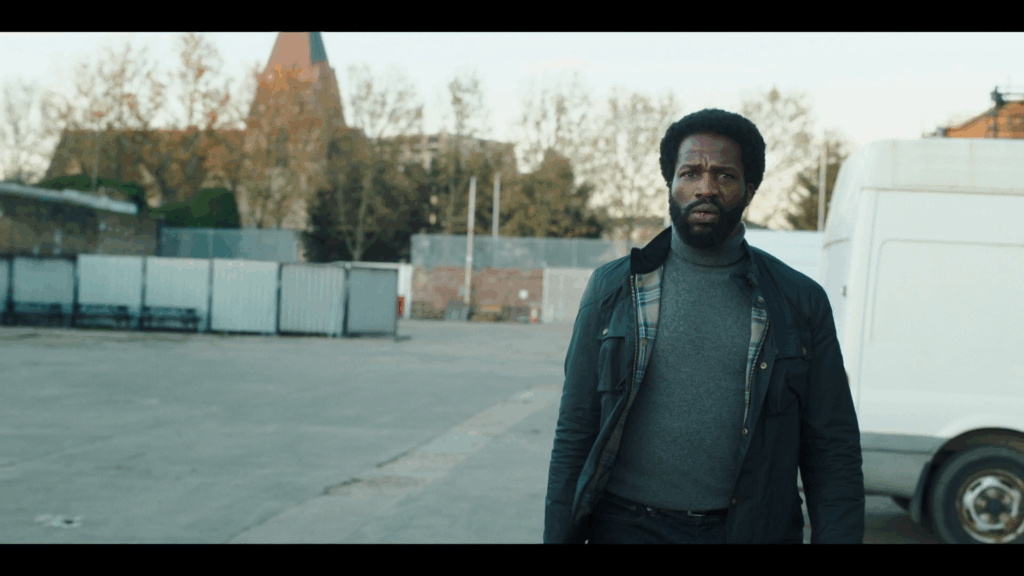
Elliot tracks the van to a seedy garage where its license plates were swapped out; he rendezvouses with Shannon, who, over his protests, tags along when he tortures the new plate number out of the garage proprietor.
Something I find curious about Elliot and Shannon’s dynamic in this episode is that there’s absolutely no romantic frisson between them whatsoever. OK, granted: he’s crushing a man’s forearm in an industrial vice while she watches. It’s not exactly a candlelit dinner. But, we’re now halfway through the Season, and they’ve only shared two scenes together; this, and the drug deal with the Koreans in S3 E1. In both scenes, Shannon comports herself as Elliot’s business associate; the dialogue they exchange is terse and guarded. (Elliot unhesitatingly lies to her when she asks where he got the information about the garage. He talks to Saba with more candour and intimacy than he does to Shannon.)
If a hypothetical viewer started watching this show in Season 3, without knowledge of Seasons 1 or 2, they would never glean that Elliot and Shannon were supposed to be lovers; not from the dialogue, nor from Dìrísù and Bennett-Warner’s performances. That seems like a pretty telling creative choice, even if – especially if – it was an unconscious one. When Simone interrogated Elliot in hospital in S3 E3, she asked him what it must have taken for a driven, idealistic detective to have enthroned himself as a drug kingpin. On paper, the answer to that question is: Shannon Dumani. In the previous two seasons, she was his Lady MacBeth; she was the one who rolled out the red carpet upon the dark path he was to walk.
Dìrísù and Bennett-Warner never had great chemistry, and Shannon was always a character that the writers struggled to integrate into the plot, but Season 3 seems uninterested in even trying. All of Elliot’s emotional energy is focused on solving the murder of his wife and son. Rather than developing and deepening his complicated relationship with the woman who beckoned him into the underworld, the writers opt instead to focus on his relationship with his dead family, whom the audience have no prior connection to or stake in. This is frustrating, because it makes Elliot feel closed-off; decontextualised from the conflicts that have shaped him for the last 16-odd hours.
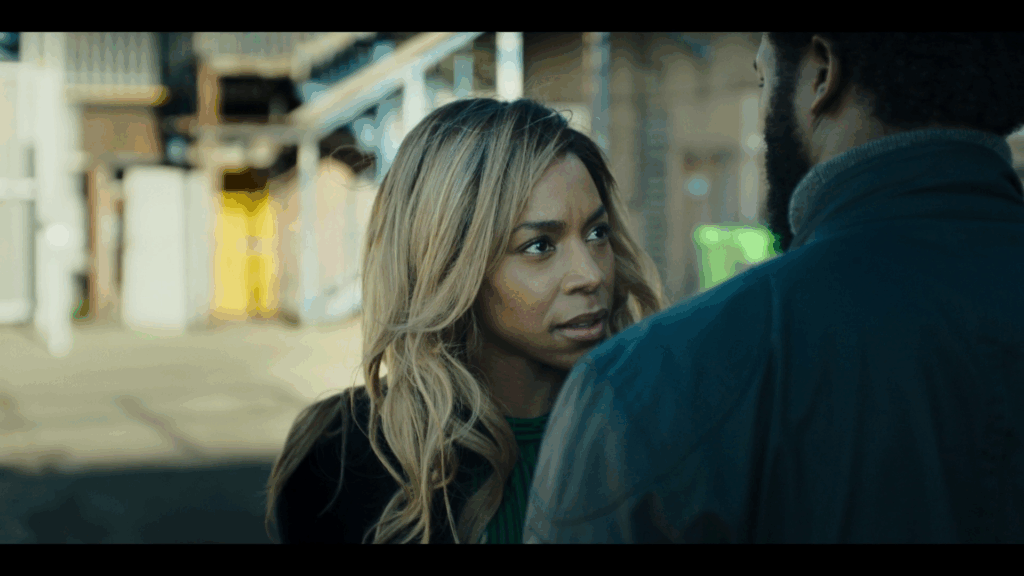
I greatly prefer the half of S3 E4’s plot involving Luan and Marian to the half that involves Elliot; it’s in the former that we find big, strident, tragic emotions, articulated clearly and with artful symmetry. Luan and Marian each have deeply felt reasons to want the other dead. He blames her for colluding with her brother and nephew, whom he holds responsible for the death of his daughter. She holds him responsible for the death of her son, as a direct result of the bounty he placed on his head. They’re both equally mistaken, but the fuse has already been lit, despite Ed Dumani’s best efforts at mediation.
A squad of black-clad Albanians converge on the church where the funeral service is being held and storm into the nave, brandishing automatic weapons. Inside, they find… no-one. The pews, the pulpit… all empty.
The doors behind them slam shut.
Marian really did love Sean, in the end, after it would have counted. She’s just as furious as Luan – and, as it turns out, smarter.
Marian really did love Sean, in the end, after it would have counted
Kim Hong-Sun and Farren Blackburn perhaps realised that Gangs of London fans were overdue for a major, extravagant showcase sequence. The action scenes in Season 3 so far have been fine, but sparse; we were owed a big, blowout gun battle, and here it is. The fusillade from assault rifles and shotguns tears the church to splinters, the Albanians scrambling for cover as the Wallaces flank them from the balconies, turning the nave into a killing floor.
It’s a pretty spectacular, satisfying action scene, well-storyboarded in pre-viz by Adam Hoton and his team, with clear, legible geography, and full of gnarly, satisfying kills (special mention has to go to the one unfortunate soul who has his arm impaled on a spiked fence post before Liam shoots him in the head). If I have one criticism, it would be that a lot of the effects – blood splatter; bullet holes; flying debris, etc. – are quite conspicuously digitally composited. This is to be expected in modern TV, and Gangs of London has always made use of digital compositing to an extent, but I feel like it’s not usually as obvious as it is here. (S1 E2 and S1 E5 both feature a lot of real explosions and props being thrown into disarray in-camera; again, I have to wonder if Season 3 was working with a reduced budget.)
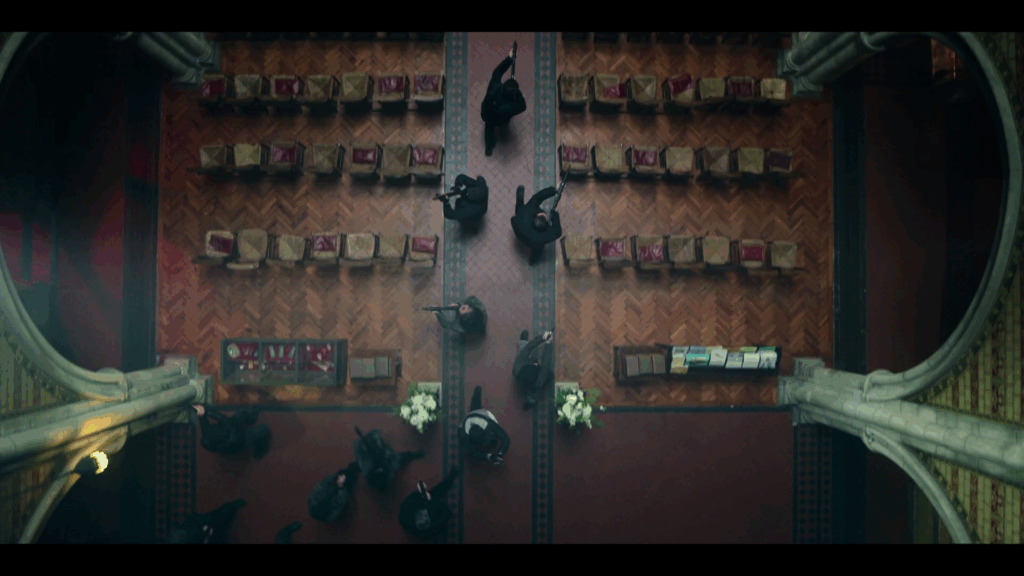
Luan’s men put up a valiant fight, but being outmanoeuvred, they’re slaughtered almost to a man by the Wallaces. Luan just manages to escape by taking Marian hostage, and even then, Billy wings him. He and his driver, Artan (Nikolaos Brahimllari) escape back to Luan’s estate, where he gathers Mirlinda and Bukuroshe and flees into the woods before Billy, Marian and Cornelius catch up. Artan – loyal to a fault – stays behind to bargain for clemency on Luan’s behalf, which goes about as well for him as you’d probably expect. No promises of business concessions are going to make this war go away.
No promises of business concessions are going to make this war go away.
Meanwhile, Elliot traces the switched out license plates to a warehouse, and almost catches Lale in the process of transferring the barrels to a new vehicle. Lale, her face covered, keeps him at bay with a few shots of suppressing fire. She destroys any forensic evidence in the old van with a grenade tossed through the rear door, and speeds away in the new van with the coke. Despite Elliot’s heroic, Jackie Chan-esque attempt to cling on to the vehicle’s rear door, she throws him off, escaping without either him or Shannon identifying her.
Lale’s a skilful operator, and she’s pretty successfully thrown Elliot off her trail; the one lead he is able to extract from the scene is one he’d never have known to look for. His eyes alight on an old fire escape, where a faded logo is emblazoned with peeling, rust-red spraypaint. He recognises it, and so does the viewer; it’s the same logo that was printed on the paperwork his wife had on her the night that she and Samuel died.
Oh yes: it’s all quite a twisted web. I have to give this to Season 3: for as much as it disregards the dynamics and relationships between characters established in previous seasons, and for as much as it freely throws the baby out with the bathwater, it’s meticulous as a self-contained mystery story. Season 1, for all its strengths, wasn’t really much of a whodunnit: by the middle of that season, it was pretty easy to figure out who ordered Finn’s murder, and why. Here at the middle of Season 3, the intrigue is more tantalising and more obscure than ever. Why is Lale doing this? Who is Zeek, and what’s his agenda? And how does it tie in with what Naomi was doing before she was killed? We’re only just starting to grasp the threads that connect these questions.
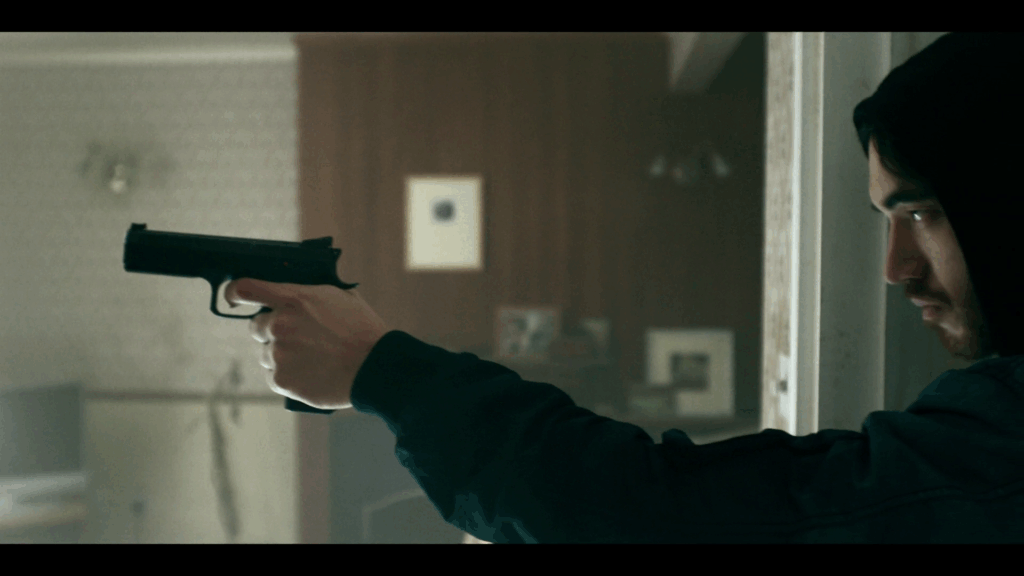
A couple more twists close out the episode. The first concerns Simone, conferring in her office with her oleaginous aide, Henry (Sebastian Armesto). He suggests that this might be the appropriate time to start pushing for a radical policy reform that she’s been hesitant to advocate for: complete drug legalisation in London. It would mean cutting the gangs’ source of revenue off at the knees, while ensuring that users have access to a quality-assured, taxable product. After the six-hundred mortalities caused by the contaminated coke, Henry supposes that the electorate is willing to listen to solutions that will move the drug trade into legal, regulated channels.
Here at the middle of Season 3, the intrigue is more tantalising and more obscure than ever.
Second, and more dramatically: Elliot returns to his father’s old flat, in the hope that he might find some documents that might shed some light on the mysterious logo. What he finds instead when he arrives is the whole shipment of Belgian beer cans, stacked ceiling high in his childhood bedroom. Stunned, he moves to leave… but before he can, Zeek walks into the room, holding him at gunpoint.
I criticised S3 E3 for feeling like a clunky gear-shift of an episode; no such criticism here. S3 E4 is an explosive 45 minutes of TV, materially moving the plot forward in dynamic, exciting ways.
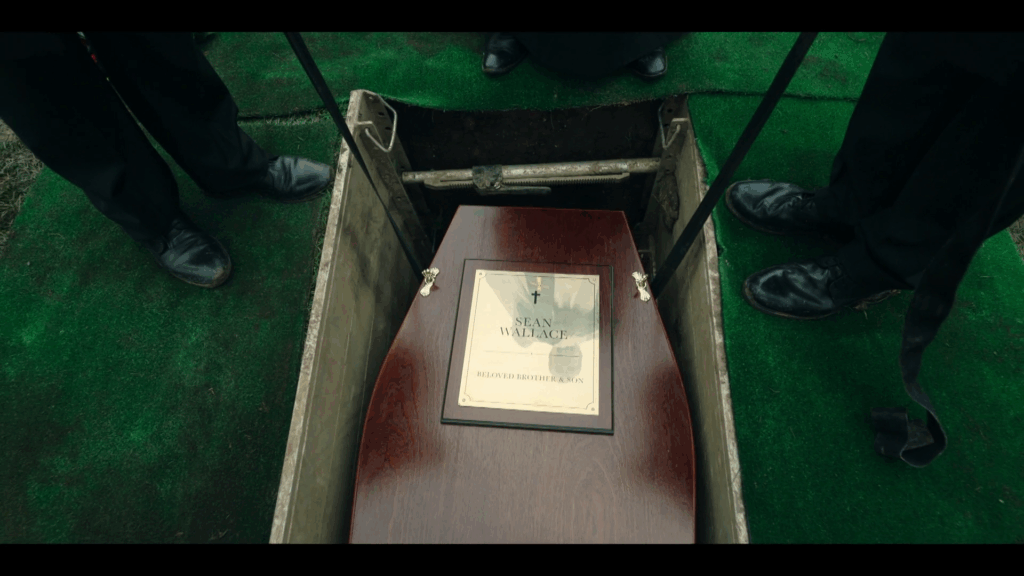
(Something I don’t think I’ve made explicit in this series of reviews, and I probably should: I’ve already seen the whole season. I binged it on NOW TV within 48 hours of its release, before I wrote the first word about S3 E1, so I do know the answers to the various mysteries it sets up, and which characters are ultimately behind it all. Rewatching the season’s first half, it’s honestly rather impressive how well the intrigue is seeded; how scenes play differently when you know which characters know more than they’re letting on.
I bring this up, because even on a rewatch, there’s a detail that still confuses me. I don’t understand how Sean figures into the poisoning plot. By now, it’s clear that Sean was telling the truth when he said he was framed for the fentanyl spiking; the way he was eliminated by the actual conspirators confirms that. But we’re given to understand that the original shipment of “clean” cocaine was swapped out for a duplicate consignment of tainted cocaine, during the 30 minutes when the haulier stopped at Cornelius’s funfair.
Here at the middle of Season 3, the intrigue is more tantalising and more obscure than ever.
So… what was actually going on during those 30 minutes, and why would Cornelius have denied seeing a truck? Was the SatNav history a deliberate misdirection by the real poisoners, with the expectation that Elliot would find it? Because that seems incredibly baroque, and also implies they knew about Sean’s communication with Cornelius. And are we to understand that the plot to break Sean out of prison was completely unrelated to the fentanyl spiking, and by an amazing coincidence, just happened to be planned for the same weekend?? Aaaaaargh.)
- Review Series: Gareth Evans
- Review Series: Gangs of London
Is It Good?
Good (5/8)
More Gangs of London reviews
Andrew is a 2012 graduate of the University of Dundee, with an MA in English and Politics. He spent a lot of time at Uni watching decadently nerdy movies with his pals, and decided that would be his identity moving forward. He awards an extra point on The Goods ranking scale to any film featuring robots or martial arts. He also dabbles in writing fiction, which is assuredly lousy with robots and martial arts.

